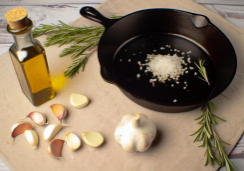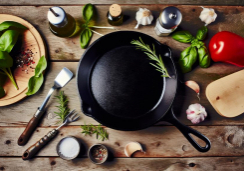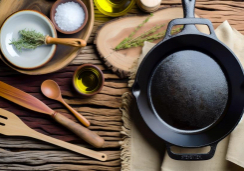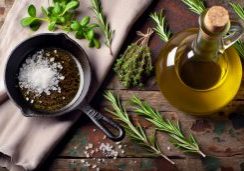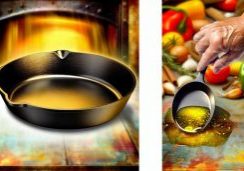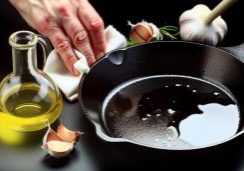Discover the Joy of Gluten-Free Baking Essentials
Have you ever considered that gluten-free baking could rival the taste and texture of traditional wheat-based treats? As you embark on this culinary journey, you'll find that mastering the art of gluten-free baking is not just about substituting ingredients; it's about understanding the unique properties that alternative flours, sweeteners, and leavening agents bring to your creations.
You're probably aware that options like almond flour and coconut sugar are staples in a gluten-free pantry, yet there's a world of other essentials waiting to transform your baking experience. With the right knowledge, you can craft bread that rises beautifully, cookies that have the perfect crunch, and cakes that are moist and tender, all without a speck of gluten.
Let's begin to unravel the secrets behind these delectable alchemies, and soon you'll be able to share baked goods that everyone, regardless of dietary preferences, can enjoy.
Understanding Gluten-Free Flours
To master gluten-free baking, you'll need to get familiar with a variety of gluten-free flours, each with its own set of characteristics that can enhance your recipes. Whether you're managing celiac disease, diabetes, or are simply wheat sensitive, the right flour mix is key to delicious and nutritious baked goods.
Almond flour, rich in protein and low in carbohydrates, is perfect for low-carb recipes, while coconut flour offers a naturally sweet flavor and high fiber content, ideal for those watching their sugar intake. Rice flour and tapioca flour are also popular choices, providing a neutral base for both sweet and savory dishes.
For those who prefer a hands-on approach, home-ground nut and seed flours bring a fresh, wholesome quality to your baking endeavors. Xanthan gum often plays a crucial role as well, giving your gluten-free bread the elasticity it usually lacks without gluten.
Baking experts like Peter Reinhart and Denene Wallace champion the use of these flours and alternative sweeteners to craft breads and pastries that rival their wheat-based counterparts. Their guidance illuminates the path for home bakers to achieve the perfect crumb and flavor, ensuring that gluten-free baking is a joy rather than a challenge.
Mastering Gluten-Free Mixes
Diving into the art of creating your own gluten-free mixes can transform the way you bake, offering both flexibility and control over the ingredients to suit dietary needs and personal tastes.
For those with celiac disease or a preference for gluten-free options, understanding how to combine home-ground nut and seed flours with other essential ingredients is key.
When you're baking without gluten, precision is critical. Measuring ingredients by weight ensures consistency in your recipes, as gluten-free baking can be less forgiving than its wheat-based counterpart.
While some gluten-free baking books may advocate for store-bought mixes, mastering your own blends allows you to omit allergens, like nuts or flaxseed meal, for a truly tailored approach.
Peter Reinhart, a baking expert, emphasizes the importance of experimenting with seed flours and alternative ingredients to achieve the desired texture and flavor. Remember though, some recipes might call for items like xanthan gum or liquid stevia, which can be a bit elusive.
Despite this, investing in these ingredients, and perhaps a good baking book, pays off. You'll find that making your own mix isn't only more cost-effective than pre-made products but also a rewarding step in your gluten-free baking journey.
Perfecting Leavening Techniques
Having explored the customization of gluten-free mixes, let's focus on the nuances of leavening techniques that are central to achieving the perfect rise and texture in your baked goods. Perfecting leavening is essential, particularly when you're dealing with gluten-free flours that can be unforgiving. Understanding the right ratios of baking powder and soda is just the start.
Master the use of natural leaveners like eggs and explore dairy-free alternatives to create light, airy textures. Peter Reinhart, a pioneer in bread baking, has a gluten-free baking book that delves into recipes that revolutionize baking with these techniques. His insights can help you navigate the tricky waters of gluten-free leavening, whether you're baking for celiac disease or personal preference.
Experiment with yeast or whipped egg whites to get that desirable structure and rise, especially in gluten-free bread baking. Each gluten-free flour—be it nut and seed flours or others—behaves differently, so it's crucial to adjust your leavening agents accordingly.
Incorporate alternative and natural sweeteners as they can affect how your baked goods rise. With these easy-to-make recipes and low-carb options that offer satisfaction without the gluten, you'll soon master the art of gluten-free leavening techniques.
Exploring Gluten-Free Sweeteners
As you venture into the realm of gluten-free baking, considering the variety of sweeteners available can enhance both flavor and texture in your creations. Whether you're managing celiac disease or simply reducing refined carbs, gluten-free sweeteners offer a world of possibilities. Renowned bakers like Peter Reinhart and Denene Wallace have revolutionized gluten-free treats, often incorporating natural sweeteners that complement the nutty depth of almond flour and the earthiness of flaxseed meal.
Navigating gluten-free baking doesn't mean you'll miss out on the sweetness. While some recipes call for niche items like xanthan gum and liquid stevia, you can often make do with what's on hand. Non-sugar sweeteners allow those with diabetes to indulge without the worry, and many of these alternatives can be substituted based on your preference.
What Baking Essentials Are Essential for Perfect Gluten-Free Baked Goods?
When perfecting gluten-free baked goods techniques, having the right baking essentials is essential. Invest in quality non-stick baking sheets, silicone baking mats, a good set of measuring cups and spoons, and a reliable kitchen scale. Stock up on gluten-free flour blends, xanthan gum, and baking powder for optimal results.
Crafting Artisan Gluten-Free Breads
While exploring the sweetness in gluten-free baking enriches flavors and textures, mastering the art of crafting artisan gluten-free breads opens a door to hearty, satisfying loaves that are sure to impress. Renowned bread maker Peter Reinhart, alongside Denene Wallace, has penned a gluten-free baking book that's a treasure trove for those who long for incredibly flavorful baked goods without the gluten. Their recipes offer solutions for celiac disease, ensuring everyone can indulge in the joy of bread.
Keep in mind, though, their approach often leans on nuts and eggs, so it mightn't suit you if you're avoiding animal products or have nut allergies. And while nut flours can ramp up your grocery bill, they're pivotal for that rich, savory taste, like in the acclaimed Italian herb bread recipe—a straightforward concoction that turns any meal into a celebration.
But be prepared; certain recipes might send you on a hunt for xanthan gum or liquid stevia. Yet, don't let this deter you. The results? Bread that's not just a mere substitute; it's a standalone marvel. With Peter Reinhart's expertise guiding you, you're set to bake up loaves that offer solutions for celiac disease and a banquet of flavors that everyone, regardless of dietary restrictions, can savor.
Conclusion
You've now mastered the art of gluten-free baking! Embrace the variety of flours, mixes, and sweeteners at your fingertips.
You're equipped to create artisan breads and treats that everyone can savor. Remember, your baking journey is a form of self-care and sharing joy with others.
So, keep experimenting, and delight in every delicious, health-conscious bite. Happy baking!

